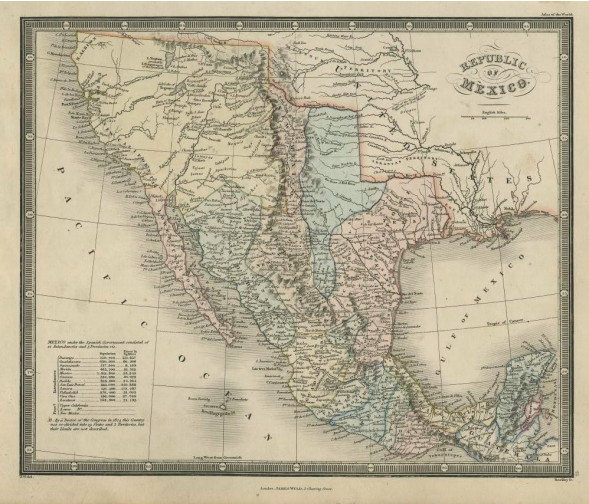1.1: Brief Political History of Texas
- Page ID
- 129174
The early ancestors of modern American Indians in Texas lived approximately 37,000 years ago and survived primarily on wild game. In East Texas, more permanent villages were established by the American Indians and federations were formed for mutual protection. They came to be known as the Caddo confederacies and farms developed along with political and religious systems. These American Indians would certainly exert influence on the history of Texas when the first Europeans arrived in 1528. The Caddos are credited with giving Texas its name which is a derivative of the Caddo greeting—“Tay-yas” or friends. Remember, the motto of Texas is “friendship”.
During the early 1700s, the Spanish sent more than thirty expeditions into Texas. San Antonio had a military post and a mission (the Alamo). Missions were also established in Nacogdoches to the east, Goliad in the south, and El Paso in the west. Moses Austin received permission from the Spanish government to settle 300 families on a grant of 200,000 acres. After Mexico won its independence from Spain in 1821, Stephen F. Austin (the son of Moses) received approval of the grant from Mexico (Map 1.1). By 1832, his colonies had about 8,000 people.

When Antonio Lopez de Santa Anna assumed the presidency of Mexico, Texans supported him. When Stephen F. Austin traveled to Mexico to address the government about restrictive government grievances, he was met with imprisonment. By the time he returned to Texas in 1835, skirmishes had already broken out among the colonists and the Mexican troops. Texas declared its independence at Washington-on-the-Brazos in 1836. The Battle of the Alamo lasted from February 23 to March 6, 1836, before all of the defenders inside the Alamo were killed. Sam Houston, the military commander, led a surprise attack on the Mexican troops at the battle on the San Jacinto River, capturing Santa Anna and securing victory for Texas. Now the Republic of Texas, Sam Houston became president and Stephen F. Austin became secretary of state. Houston became the capital of the republic until it was later moved to Austin as the permanent capital. The Republic struggled both financially and with the constant threat of American Indian attacks. The U.S. wanted to continue expanding to the west, so the U.S. and Texas agreed to annexation in 1845, and fortunately Texas managed to retain title to its public lands.
After annexation, disputes over boundaries led to the Mexican-American War with U.S. troops capturing Mexico City. Mexico gave up its claim to Texas and other areas in what is now lands in New Mexico, Utah, Nevada, Arizona, and California with the Treaty of Guadalupe Hildago which was signed on February 2, 1848. Texas claimed most of that land but relinquished it in the Compromise of 1850. This was a series of bills passed by Congress to help settle disputes between the slave and free states as the U.S. expanded westward and continued to claim new territory. It also set the current northern and western boundaries of Texas. More disruption occurred with the onset of the American Civil War. Texas joined the Confederacy in 1861 and then rejoined the Union in 1870 after losing the war. The Reconstruction period after the war brought a political atmosphere of distrust of government in general. When Texans wrote the constitution of 1876 under which we are still operating they took care to ensure limitations on all three branches of government. As stated in Article I, Section 2 of the 1876 Texas Constitution:
All political power is inherent in the people, and all free governments are founded on their authority and instituted for their benefit. The faith of the people of Texas stands pledged to the preservation of a republican form of government, and subject to this limitation only, they have at all times the inalienable right to alter, reform, or abolish their government in such manner as they may think expedient.\(^1\)
There is no doubt that a limited government was the preference, not only in 1876 but today as well.
Before the close of the nineteenth century, the population of Texas grew as did the economy. By 1900, the population was more than three million people. The Comanche were moved out of Texas to a reservation in Oklahoma. New immigrants arrived and towns were established. The cattle industry and farming spread from Central Texas to West Texas. And, of course, in 1901 when the oil gusher of Spindletop outside of Beaumont was discovered, the oil industry took off and more jobs were created. Even today, cotton, oil and cattle are major industries.
- Texas Const., art I, § 2.

